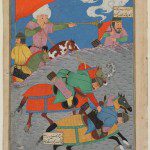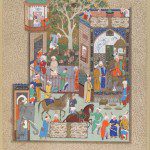“Shahnama: 1000 Years of the Persian Book of Kings” at the Sackler
By • July 26, 2011 0 1910

The thousand-year-old “Shahnama,” or Persian book of kings, is resplendently represented
in a jewel of a show at the Arthur M. Sackler Gallery. “Shahnama,” written by the revered ninth century Persian poet Firdawsi, is “in its cultural significance and popularity on equal footing with the works of Shakespeare, Homer and the Mahabharata,” says Massumeh Farhad, chief curator and curator of Islamic art, and organizer of the exhibition.
It is impossible to overstate the cultural importance of Firdawsi. It is not a subtle fact that Arabic is not the national language of Iran, a predominantly Muslim country. Firdawsi’s writing of the “Shahnama”
revived Farsi and made it the cultural as well as the everyday language of Iran. Farsi is spoken in part of Afghanistan, but it was also the court language of the Mughals in India. Firdawsi did this through retelling the actual and sometimes mythical and fantastical stories of the Kings of Iran until the Arab conquest in the seventh century. Included in the tales are three women monarchs. The “Shahnama”
also uses the “Avesta,” a collection of texts sacred to the Zoroastrians, as one of its sources.
The “Shahnama” is not a simple book of myth and history. It also emphasizes justice, a concept that perhaps came into Judaism during contact with the Persians. It also emphasizes divine glory, known as “farr” in modern Farsi.
What can make the eye feel the sublime through color more than the Persian miniature? There is nowhere that greater pleasure can be taken in the concise and daring juxtapositions of shape and intense color in miniatures, including the “Court of Jamshid.” When Jamshid ruled, it is told that, “The world submitted to him, quarrels were laid to rest.” He is credited with establishing the Iranian celebration of Now-ruz, a festive celebration of spring even marked by US presidents with special broadcasts to Iran. It is also said that in the reign of Jamshid, “Men knew nothing of sorrow and evil…and the land was filled with music.” The celebration of Now-ruz as well as music was antithetical to the prevailing religion in Iran. In fact, the current government tried to ban Now-ruz.
In another miniature the tyrant Zahhak, who ruled for a thousand years, is resplendent in red with green sleeves on a low throne embellished with floral design. Behind him are mauve rocky hills. It is said during his reign the wise had to conceal themselves, which is much the same sort of history recounted in the “I Ching.”
One thing to note is that these miniatures were pages in books and were not imagined by their creators as hanging on a wall. Looking at them it is best to imagine holding them in your hands.
The spaces around the figures in the miniatures are often lyrically imagined gardens created in hues of passion. The name “Firdawsi” is a penname, as the word actually means paradise—and paradise in Persia is a garden. Through April 17th, 2011 at the Sackler Gallery.
- Battle Between Zangaand Awkhast From a Shahnama(Book of Kings) by Firdawsi(d.1020) Gilan, Iran. Turkomanperiod, 1493-1494. Opaque watercolor, ink and gold on paper.



